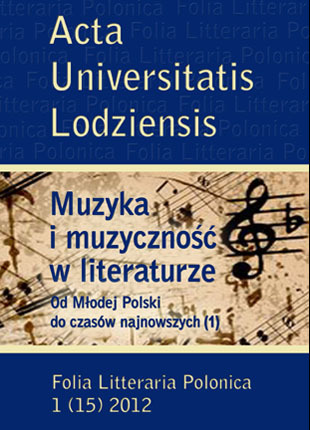Franz Liszt i jego muzyka fortepianowa w ujęciu Jarosława Iwaszkiewicza oraz Pawła Kubisza
DOI:
https://doi.org/10.18778/1505-9057.15.14Abstrakt
Franz Liszt is one of the greatest artists of the 19th century. He has attended the most important artistic and social events providing comments on their literature and musical aspects. In his articles published in ‘Gazette Musicale’ (1835—1841) he treats the artist, their place in the society till in his correspondence he reflects the life condition of the workers. This social sensibility can be observed in Lyon (1837) in the cycle Impressions et poesies.
The literature was one of his main interests. All his life he kept reading and commenting in his correspondence the works he had read and most importantly he tried to implement it in his musical works. The result of these attempts was the creation of the program music, a music inspired very often by the literature or preceded by a literature piece.
In my article I am presenting the music of Liszt that has inspired literature deeds. My research is directed towards two works — the novel entitled Mefisto-Walc by Jarosław Iwaszkiewicz and the poem by Paweł Kubisz entitled Rapsod o Oszeldzie. Both are very different. In the first work it is the music (Erster Mephisto-Walzer) one of the main actors, equal to the others, the composer is just mentioned. In the work of Kubisz, Liszt is a principle actor who inspires the struggle of the workers and leads towards liberty and his music occupies secondary place (Lyon, Mazeppa, Mephisto-Walz).
Both the works have one common point — Franz Liszt and his music. They both also refer to Faust. Ein Gedicht of Nikolas Lenau that has preceded Erster Mephisto-Walzer. They both have not only a common musical intertext but also a literature intertext though the musical work, what I have called intertext of second degree. This is proof that Liszt was right that it is possible to implement the ideas in the music.
Pobrania
Pobrania
Opublikowane
Jak cytować
Numer
Dział
Licencja

Utwór dostępny jest na licencji Creative Commons Uznanie autorstwa – Użycie niekomercyjne – Bez utworów zależnych 4.0 Międzynarodowe.











